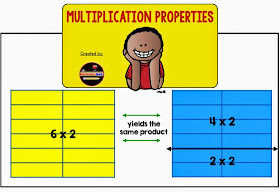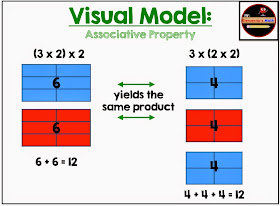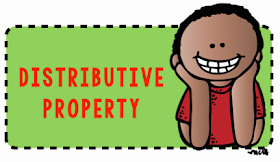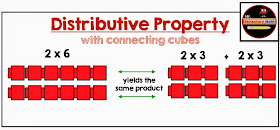In this post, I will focus on the following 3 properties that are used with addition and multiplication:
- Commutative Property
- Associative Property
- Distributive Property
Let's take a closer look at how the properties relate to multiplication.
The commutative property states that changing the order of the factors does not change the product. The root word of commutative is commute or interchange (refer to the chart below). I know that maybe too much information...... but I thought it was interesting.
The commutative property can be very confusing to students, such as in the example 8 x 2 = 2 x 8. Although both equations represent the same amount or product, representing them with a visual model looks different (eight groups of two versus two groups of eight). See below.
- Providing students with tiles or counters and asking them to model 8 x 2 & 2 x 8; 3 x 4 & 4 x 3, 5 x 3 & 3 x5. Then ask the students to compare the product of each factor pair (ie. 8 x 2 and 2 x 8). Students should be able to explain that the products are identical. To sum it up, students should model, model, model multiplication equations in any order to see if the products are always identical.
Using 3 x 2 x 2 as the basis of our groupings, below you will see a visual model of how the associative property works.
An idea to help with the associative property may be:
- Providing the students with counters or tiles and asking them to model (3 x 2) x 2 and then 3 x (2 x 2); like the example above. From this point allow the students to determine patterns they notice. Consider asking the students: What is the product of both expressions? Why do they think the product is the same for both? Try this investigation with different expressions including: (5 x 2) x 2 and 5 x (2 x 2), (3 x 4) x 2 and 3 x (4 x 2). Students should begin to generalize that changing the groupings does not change the product.
Last but certainly not least is the distributive property. The distributive property basically lets us spread out the factors so that the numbers are easier to work with. We use this a lot when multiplying mentally. For example, if asked to mentally find the product of 54 x 3, many of us would decompose 54 into 50 and 4. We could then say that (50 x 3) + (4 x 3) = 150 + 12 = 162.
Check out the visual model of distributive property below:
An idea to help with the distributive property may be:
- Asking students to model 2 groups of 6 (2 x 6) using connecting cubes and find two hidden facts inside of 2 x 6 like 2 x 3 and 2 x 3. Allow the students time to discover as many hidden facts inside of the 2 x 6 that they can. Try this out with different multiplication facts through 10 x 10. Do not forget to ask students what they notice as they are doing this investigation.
Click Here to Download Your Quick Reference Sheet
Multiplication properties can seem tough, but with scaffolded support our students can definitely get it. Consider how people use these properties in every day life to figure out problems (i.e. when shopping). As students grasp the properties, they will become better mathematicians!











As usual, your models look great!
ReplyDeleteTara
The Math Maniac
Thanks Tara! It took a while, but I really wanted to represent the properties with clear images because I am a visual person. I appreciate your comment. It makes the work worth it!
DeleteGreg
This activity covering properties is a great way to get student to learn the difference between commutative, associative and distributive properties. I especially love the idea of the visuals, which gives them a go-to on what is correct. Great Activity!
ReplyDeleteWhen I downloaded your Quick Reference Sheet for Properties, I get a file 404 error message. Am I too late?
ReplyDeleteI am sorry to hear that you are having difficulty downloading the Quick Sheet. Don't worry you are not to late, it is free FOREVER : ) I just checked the link myself and I was able to downloaded with no problem. Please email me at mrelementarymath@gmail.com and I will ensure that you receive it.
DeleteGreg
While I love your area models I often find the younger children can better grasp the commutative property via a group model e.g 2 plates of 4 cookies = 2 x 4 whereas 4 plates of two cookies looks much different, 4 x 2. Still 8 cookies in total though! I use the phrase "same value, different appearance" to help explain it.
ReplyDeleteSee more here: https://sites.google.com/site/primarycpd/latest-news/multipleways
Claire
Thanks for your comment Claire. It love the phrase same value, different appearance.
DeleteGreg
Hi Greg. This is great info.
ReplyDeleteIn my experience, teachers often miss the 'second' Distributive Property. Let me explain... Teachers sometimes say integer multiplication is repeated addition because multiplication distributes over addition. For example:
2 × (+4) = 2 × (0 + 2 + 2) = 2 × (0 + 1 + 1 + 1 + 1) = 0 + 2 + 2 + 2 + 2 = 0 + 8 = 8
Yet multiplication also distributes over subtraction. For example:
2 × (-4) = 2 × (0 – 2 – 2) = 2 × (0 – 1 – 1 – 1 – 1) = 0 – 2 – 2 – 2 – 2 = 0 – 8 = -8
So integral multiplication of 'a multiplied by b' written as a × b involves EITHER a added to zero b times in succession OR a subtracted from zero b times in succession, according to the sign of the multiplier.
If you and your readers would like to know more about multiplication, you can watch my 'Lost Logic of Elementary Mathematics' slideshow, (online via Microsoft OneDrive), at:
https://1drv.ms/p/s!AiiJ6XgphELidETf6CoiWWpuGec
My elementary math paper exploring multiplication is at http://bit.ly/LostLogicOfMath
Best wishes to you and your readers for a happy and healthy 2017!
Jonathan Crabtree
http://www.jonathancrabtree.com/mathematics